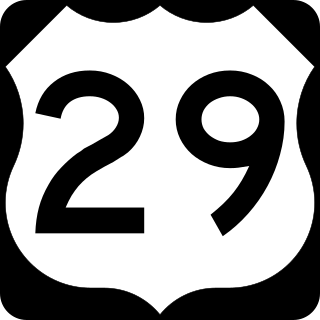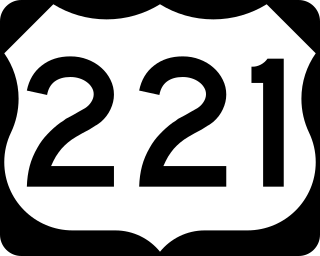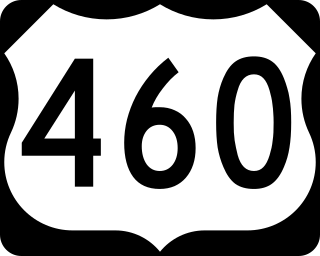The Lynchburg Expressway is a freeway in Lynchburg, Virginia, United States. It carries portions of
The Lynchburg Expressway is a freeway in Lynchburg, Virginia, United States. It carries portions of

Lynchburg is an independent city in the Commonwealth of Virginia in the United States. First settled in 1757 by ferry owner John Lynch, the city's population was 79,009 at the 2020 census, making Lynchburg the 11th most populous city in Virginia. Located in the foothills of the Blue Ridge Mountains along the banks of the James River, Lynchburg is known as the "City of Seven Hills" or the "Hill City". In the 1860s, Lynchburg was the only city in Virginia that was not recaptured by the Union before the end of the American Civil War.

Amherst is a town in Amherst County, Virginia, United States. The population was 2,231 at the 2010 census. It is the county seat of Amherst County.

Lynchburg is a city in the south-central region of the U.S. state of Tennessee. It is governed by a consolidated city-county government unit whose boundaries coincide with those of Moore County. Lynchburg is best known as the location of Jack Daniel's distillery, whose famous Tennessee whiskey is marketed worldwide as the product of a city with only one traffic light. Despite the operational distillery, which is a major tourist attraction, Lynchburg's home county of Moore is a dry county. Sampling whiskey is permitted in the distillery, however. The population was 6,461 at the 2020 census.
Lynchburg is a toponym that may refer to:

The James River is a river in Virginia that begins in the Appalachian Mountains and flows from the confluence of the Cowpasture and Jackson Rivers in Botetourt County 348 miles (560 km) to the Chesapeake Bay. The river length extends to 444 miles (715 km) if the Jackson River, the longer of its two headwaters, is included. It is the longest river in Virginia. Jamestown and Williamsburg, Virginia's first colonial capitals, and Richmond, Virginia's current capital, lie on the James River.

U.S. Route 29 or U.S. Highway 29 (US 29) is a north–south United States Numbered Highway that runs for 1,043.3 miles (1,679.0 km) from Pensacola, Florida, to Ellicott City, Maryland, just west of Baltimore, Maryland, in the Eastern United States, connecting the Florida Panhandle to the Washington–Baltimore combined statistical area. The highway takes on an overall northeast–southwest direction, from its southern terminus at US 90 and US 98 in Pensacola to its northern terminus at Maryland Route 99 (MD 99) in Ellicott City.

U.S. Route 501 is a spur of U.S. Route 1. It runs 355 miles (571 km) from Buena Vista, Virginia at U.S. Route 60 to Myrtle Beach, South Carolina at U.S. Route 17 Business. It passes through the states of Virginia, North Carolina and South Carolina. From Durham to Laurinburg, a 108-mile (174 km) section of US 501 overlaps U.S. Route 15. Sections of US 15-501 also share routings with U.S. Route 1 in sections near Sanford, North Carolina and Aberdeen, North Carolina.

U.S. Route 221 (US 221) is a 734-mile-long (1,181 km) spur of U.S. Route 21. It travels from Perry, Florida, at US 19/US 98/US 27 Alternate to Lynchburg, Virginia, at US 29 Business. It travels through the states of Florida, Georgia, South Carolina, North Carolina, and Virginia. It travels through the cities of Valdosta, Georgia; Spartanburg, South Carolina; Marion, North Carolina; Roanoke, Virginia; and Lynchburg, Virginia.

U.S. Route 460 (US 460) is an auxiliary route of U.S. Route 60. It currently runs for 655 miles (1,054 km) from Norfolk, Virginia, at its parent route U.S. Route 60 at Ocean View to Frankfort, Kentucky, intersecting its parent route once again. It passes through the states of Virginia, West Virginia, and Kentucky. It goes through the cities and towns of Norfolk, Portsmouth, Suffolk, Petersburg, Farmville, Lynchburg, Roanoke, Christiansburg, Blacksburg, Tazewell, and Grundy, in Virginia; Princeton and Bluefield in West Virginia; and Pikeville, Georgetown, and Frankfort in Kentucky.

Lynchburg is an unincorporated community in southeastern Laclede County, Missouri, United States. It is located at the intersection of Missouri routes 32 and 95, approximately 30 miles southeast of Lebanon.

U.S. Route 29 (US 29) is a major north–south route in the commonwealth of Virginia. It covers 248.0 miles (399.1 km) from the North Carolina border at the city of Danville to the Key Bridge in Washington DC. US 29 roughly bisects Virginia into eastern and western halves and, along with Interstate 81 (I-81) and US 11 in western Virginia and I-85/I-95 as well as US 1 farther east, provides one of the major north–south routes through the commonwealth.

U.S. Route 221 (US 221) is a part of the U.S. Highway System that runs from Perry, Florida to Lynchburg, Virginia. In Virginia, the U.S. Highway runs 149.61 miles (240.77 km) from the North Carolina state line near Independence north to its northern terminus at US 29 Business, US 460 Business, and US 501 Business in Lynchburg. US 221 connects Independence, Galax, and Hillsville in Southwest Virginia while running concurrently with US 58. The U.S. Highway connects those communities with Roanoke via Floyd County, within which US 221 is the main east–west highway. Entering Bedford County, US 221 exits the Blue Ridge Mountains; it then passes through the Piedmont town of Bedford on its way to Lynchburg and shares a brief overlap with US 460 Business through the town. The U.S. Highway also runs concurrently with US 460 from Roanoke to Bedford and parallels that U.S. Highway from Bedford to Lynchburg.

State Route 128 is a primary state highway in the U.S. state of Virginia. Known for most of its length as Mayflower Drive, the state highway runs 3.47 miles (5.58 km) from SR 163 north to U.S. Route 460 Business and US 501 Business within the independent city of Lynchburg.

State Route 163 is a primary state highway in the U.S. state of Virginia. The state highway runs 6.74 miles (10.85 km) from U.S. Route 501 and US 29 Business in Lynchburg north to US 29 Business in Madison Heights. SR 163 is the original alignment of US 29 through Lynchburg, a highway has been twice bypassed: first by the Lynchburg Expressway and later by US 29's present bypass. The state highway provides access to downtown Lynchburg and many other historic neighborhoods of the independent city.
Fort Avenue may refer to:

Concord is a census-designated place (CDP) in Appomattox and Campbell counties in the U.S. state of Virginia. The population as of the 2010 census was 1,458.

Several special routes of U.S. Route 29 (US 29) exist. In order from south to north, they are as follows.

A total of at least eight special routes of U.S. Route 501 exist and at least four have been deleted.